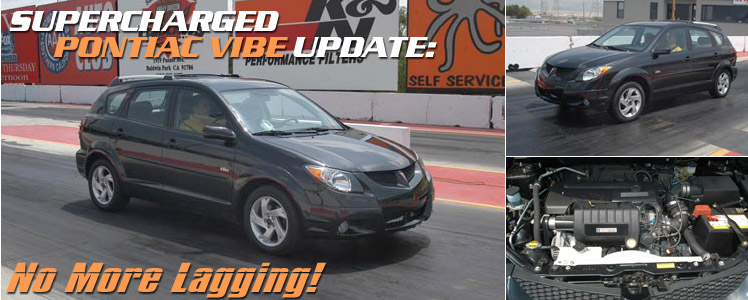
|
Supercharged
Pontiac Vibe Update: No More Lagging! Page: [1] Yeah, we know; you’ve heard it and read it before: The Vibe is getting a supercharger. Problem is, when you called the dealer, he acted as if you were inquiring about next year’s Academy Award winners. Well, guess what? We’ve actually driven the s/c Vibe, and, according to the latest promise from GM, the hardware will be at the dealerships in June. For those who have already read the previous articles on the supercharger at genvibe.com, you know this unit is a Roots-type manifold design that will bump horsepower and torque figures up to 35 percent, going from 130 hp to about 176, and moving the torque from 125 to 167. Compared to the GT model (at 180 hp and 130 lb-ft of torque), the horsepower difference between the two is minimal, while the base model gains a lot more low-end grunt. And even though it’s only a month away, no final numbers will be supplied until the certified dyno testing is finished. The supercharger is a joint-venture between Toyota Research and Development (TRD) and Pontiac, but the units will not be interchangeable since they will have different wiring and engine control units; you need to make sure you’re buying a GM Performance Part from an authorized GM dealership for your Vibe, even if the Toyota dealership is closer to your house, and the units basically look the same. The good folks at GM also haven’t announced a price yet, but say it will be a bit less than what the asking price is for the supercharger on the 2.4-liter twin-cam kit, which can be purchased for a Sunfire or Chevy Cavalier for under $3000. We confirmed that the supercharged Vibe will not be a factory model; however, the customer can order a base Vibe with the LD9 1.8-liter I4 engine and purchase the supercharger at the same time, and before picking up the vehicle, can have it installed at the dealership. The supercharger won’t be available on either the AWD or the GT models, but you can get it with either an automatic transmission or the manual shifter. We suggest having the dealership do the dirty work, since it changes the warranty from the do-it-yourself time of 12 months/12,000 miles to the standard 3 years/36,000 miles. Since the last time you saw the supercharger on the Vibe, the part has been refined to provide optimum placement inside the engine bay. Clearances had to be double-checked, which dictated the change in positioning you can see in the new photos. In addition to the supercharger, you can order the Vibe Sport Package, which includes a variety of ground-effects add-on parts that add some zoominess to your Vibe.
We got a chance to take a couple of runs down the dragstrip at Irwindale Speedway in the Vibe with the extra power, and found it to be much more responsive off the line than the base engine, even with the automatic transmission. We can imagine how much more fun it would be once the manual tranny is added. The benefit of a supercharger versus turbocharging is that the power remains progressive all the way through the powerband, unlike a turbo, which gives you a strong kick off the line but doesn’t sustain the performance at the high end. The supercharger was quiet, and didn’t feel like an added-on component that was all show and no go. While some may question the logic behind adding on a supercharger when you could just buy the higher-powered GT version for about the same amount of money, it’s a good time to remind them that when it comes to insurance, especially for those in the age bracket where it’s going to cost in the thousands, a four-cylinder base model always looks better on paper than the initials “GT.” Another benefit to buying the GM Performance Parts supercharger versus an aftermarket brand has to do with durability requirements. Anything that comes out of GM has to meet strict standard for performance, durability, and reliability. We’re talking 10,000-mileage durability tests, heat sink trials, Pikes Peak hill climbs for altitude changes, and a 300-hour durability schedule on the dyno that involves the engine running at peak torque then peak horsepower in alternate runs for almost two-weeks non-stop. No independent manufacturer has the time nor the funds to do this thorough testing. GM has big plans to extend its performance parts segment of the aftermarket industry, and eventually will have a lot of backing at the retail level inside dealerships. If the supercharger proves to be a popular piece, look for more goodies to come for the entire Vibe lineup. Page: [1]
|
|